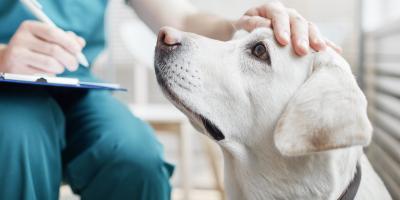Signs & Symptoms of Overheating in Dogs


Most of the time, dogs are pretty good communicators. For example, dogs communicate vocally and through body language when they want to go outside, feel like playing or think you should give them a tasty treat.
Unfortunately, dogs can’t always tell us when they’re not feeling well—like when they’re overheating. That’s why it’s vital to watch for the signs of overheating in dogs when the weather gets hot.
Dogs cannot regulate their body temperature by sweating the way people do. Instead, dogs rely on panting and behaviors like digging or finding a shaded area. While most adult dogs are good at controlling their body temperatures, problems can arise when they’re put into stressful situations or placed somewhere where they can’t find a place to cool down.
Puppies and senior dogs may struggle with temperature control even more, so be mindful of this during the warm months.
For example, a dog left in a car on a hot or even warm day can overheat quickly, which is why dog owners should never leave their dog alone in the car, even for a few minutes.
How to Tell if Your Dog Is Overheating
It is important to be aware of the signs of overheating, so you can take steps to help your dog cool down or, when necessary, get them treatment. “While a slight case of overheating can cause discomfort and anxiety, the situation can advance to serious health problems if not attended to immediately,” says Dr. RuthAnn Lobos, veterinarian and Purina’s Senior Manager of Training. “As a dog’s body temperature rises, the dog compensates by panting. Panting draws colder air to the back of the throat and across the tongue, which cools the blood circulating to the core of the dog.” It also allows heat to be emitted through their breath.
Panting also allows moisture to evaporate from dogs’ mouths, tongues and mucous membranes, which helps dogs cool down. This effect can be diminished or neutralized by humidity, though. High humidity increases the risk of overheating because it reduces the impact of panting since the saliva evaporates less quickly.
While panting is an effective short-term solution, it’s inefficient at lowering body temperature in the long run because panting itself uses energy, which generates additional heat.
Dog Overheating Symptoms
- Panting: While panting isn’t necessarily a cause for alarm, it is an indicator that your dog feels the need to cool down and it can be an early warning sign. If the length and width of the tongue grow, it’s a sign their body temperature is rising.
- Forceful or heavy panting: As a dog owner, you’re familiar with your dog’s breathing, so when their panting starts to be more pronounced than usual, it’s time to cease all activity and get your dog to a cool place with plenty of water.
- Depression: As a dog tires, they may become less animated, and their facial expression may show signs of concern or apprehension.
- Slowed pace/motor skills: An ill or stressed-out dog may slow their pace or cover less ground.
- Lowered tail: Lower tail carriage and less tail action are also indicators of a dog not feeling well.
- Rapid heartbeat: As dogs overheat, they begin to get dehydrated and the amount of blood volume decreases. This causes strain on their internal organs, causing their heart to compensate by beating faster, increasing blood pressure.
If your dog displays any of these symptoms, reach out to your veterinarian or local emergency animal hospital immediately.
How to Prevent Your Dog From Overheating
If it’s a warm day or you and your dog are in a warm or hot environment, here are some essential steps to take to help prevent your dog from overheating:
- Make sure there’s plenty of cold water available for your dog
- If you’re outside, try encouraging your dog to play in a sprinkler, pool or stream
- Offer them access to plenty of shade if they start to feel overheated
- Allow them time to rest if they seem to be panting too heavily or show other symptoms indicating they’re getting too hot—bring them inside into air conditioning
- Check the pavement and make sure it isn’t too warm for your dog to walk or play comfortably—if it’s too hot to put the palm of your hand on for five to eight seconds, it’s too hot for your dog’s paws
- Never leave a dog in a parked car on a hot day
- If your dog is indoors, keep the environment temperature-controlled
- Crated dogs should be in a cool place with good air circulation
- Keep a close eye on puppies, senior dogs, dogs with health problems or dogs with respiratory problems
- Watch dogs with dark-colored coats or double-coats, as they may be more prone to overheating
Discover more about dogs and get tips from our experts on our Pet Expertise page.
Related articles

Reward Yourself with myPurina
Earn and redeem rewards for Purina products with the myPurina app.






